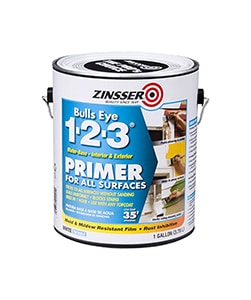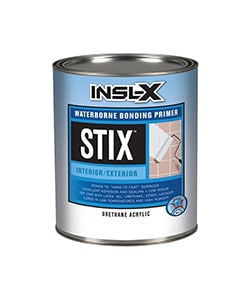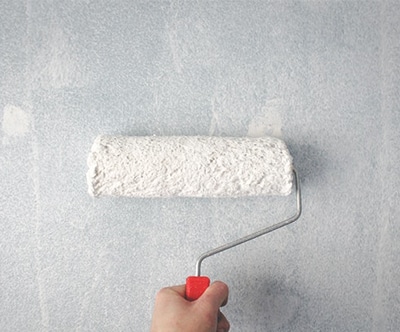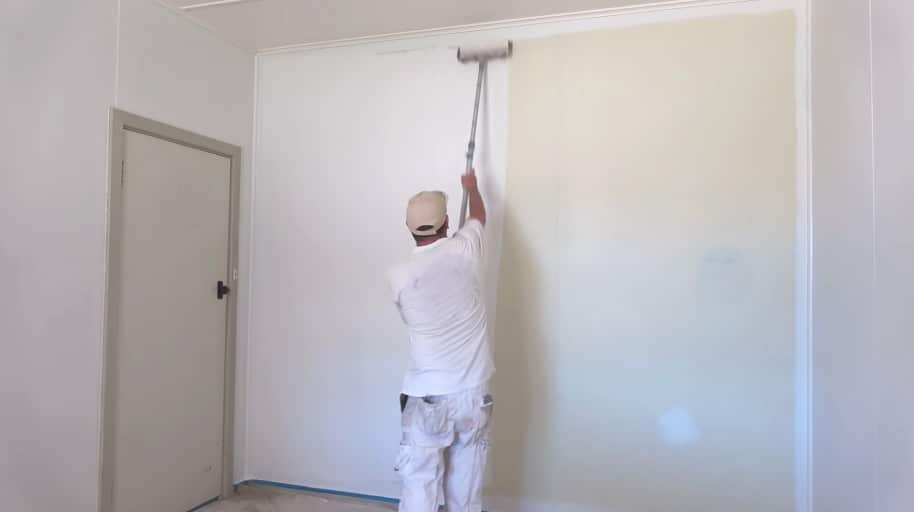GordonsToolsBlog is reader-supported. When you buy through our links, we may earn a commission at no cost to you.
Drywall primer differs from paint in several ways. Its primary component is polyvinyl acetate (PVA), which is also found in carpenter adhesive. The purpose of drywall primer is to encapsulate porous surfaces such as papers and cured joint compounds, making it easier for new paint to adhere.
Drywall primer is like a magnet for finished paint because of its glue-like basis, which aids in good color adhesion. Neglecting to prime your walls can result in stripped paint, particularly in humid conditions. Even weeks after the paint has hardened, washing may be more challenging due to the lack of adhesion. Therefore, it’s essential to use drywall primer before painting your walls for optimal results.
Priming is commonly used to cover dark colors to make it easier for the finished topcoat to hide better. Priming patched after crack areas is also a good practice.
When it comes to priming stains caused by writing, mold, or smoke damage, it’s critical to use a primer first to prevent them from bleeding through to the finished top coat. To help you make an informed choice, we’ve compiled a list of the best drywall primers with an in-depth review of each. With this information, you can assess which primer will work best for your needs and ensure a successful paint job.
All of the products chosen for this review have been assessed against several features, longevity, and the value they provide for the price at which they are available. They went under very strict criteria for being here on the list to ensure that all the products work as advertised and will get your work done efficiently. The three drywall primers chosen for this review will be accompanied by their pros and cons, which will help you further analyze the offering of each one.
Drywall Pain Primer Recommendations
1. 1-2-3 Primer by Rust-Oleum Zinsser – The Ultimate Solution for Interior and Exterior Paint Jobs

Zinsser is a highly regarded brand in the world of paint and primer, known for producing long-lasting, high-quality products. Their prices are also very reasonable, making them a pocket-friendly choice for many consumers. The 1-2-3 all surface primer from Zinsser is no exception, and has garnered a lot of positive attention for its effectiveness and affordability.
Its smooth application and the fact that it’s one gallon offers extra coverage, giving it an edge over other similar products. It also has fast-drying power, so you can go with the topcoat in about an hour from putting it up.
This primer is listed as the number #1 product in our list because this water-based solution gets easily applied without leaving behind any feeling of sanding. Although it is thinner than expected, it will still get the job done efficiently without costing you extra bucks. So, if you are looking for a primer that makes it easy to apply paint over difficult surfaces, then this should be your go-to product.
- Finish: Matte
- Type (Base): Enamel
- Coverage (ft. per quart): 87 – 112
- Use for: Interior and Exterior
- Stain-resistant: Excellent
- Odor-blocking: Low odor
- Dry time: 35 minutes
- Formula: Water-based
- Surface Recommendation: Metal, Masonry
- Has the ability to adhere well to all kinds of surfaces
- Has low VOC, and though it may have a slight smell, it tends to go away after some time
- Doesn’t peel or chip at all (however, sand the surface before using it)
- Contains chemicals and harmful ingredients (make sure to use it in a properly ventilated area)
- Has a thin consistency and will require two to three coats to give proper coverage
2. Kilz Restoration – Interior Latex Primer/Sealer

Kilz primers are definitely worth the hype they receive. They are often touted as the closest thing to a one-coat primer, and for good reason. Kilz primers offer excellent coverage and produce impressive results, all at an affordable price point. It’s no wonder they have gained such widespread fame and popularity.
This primer is effective against difficult spots such as rust, smoking, grease, ink, pencil, felt marker, pet stains, and much more. It is also created with the aid of a modern innovation that allows it to perform similarly to an oil-based solution.
Do you have your hardwood smelling of your pet’s waste? If yes, then this product is for you! We recommend this interior latex primer by Kilz because of its ability to hide tough stains due to its oil-based performance. Also, the fact that it can seal strong odors such as pets, fire, and smoke makes it better than some drywall primers.
- Finish: Matte
- Type (Base): Enamel, Oil
- Coverage (ft. per quart): 75 – 100
- Use for: Interior
- Stain-resistant: Excellent
- Odor-blocking: Strong odor-blocking
- Dry time: 30 minutes
- Formula: Water-based but perform like an oil-based primer
- Surface Recommendation: Metal
- Quite effectively eliminates the smell of pet waste in no time
- Available at extremely reasonable rates
- Hides large and stubborn stain efficiently without leaving behind any trace
- Has a very strong smell when drying
- Have to apply two to three coats to fully eliminate the stains and smell
3. INSL-X Stix – Waterborne Bonding Primer

Last but not least, INSL-X Stix is a top contender when it comes to primers, and is highly recommended by many potential buyers. It is known for its excellent adhesion capabilities, making it a great option for those who prefer not to use solvent-based (oil) primers. If you’re looking for a high-quality, effective primer, INSL-X Stix is definitely worth considering.
This waterborne bonding drywall primer has low VOC and offers an easy cleaning mechanism simply with the help of soap and water. It also offers excellent adhesion and an outclass finish. It even enables the users to use any type of coating on it, which makes it the best for its price.
Even though it takes quite some time to dry out, definitely a little longer than other products, it still is one of the best drywall primers available if you need it for bonding the hard-to-coat surfaces and then later on top it off with any covering of your preference.
- Finish: Matte
- Type (Base): Enamel, Acrylic
- Coverage (ft. per quart): 75 – 100
- Use for: Interior and Exterior
- Stain-resistant: Good
- Odor-blocking: Average
- Dry time: 3 to 4 hours
- Formula: Acrylic-urethane
- Surface Recommendation: Doors, Walls
- Adheres exceptionally well to ceramic tiles
- Glides easily on and makes the priming step a whole lot simplified
- Works like a charm leaving behind a matte finish
- Will peel off if you touch it before it is completely touch dried
- Underlying paint often shows because the consistency is thin

The Ultimate Guide to Choosing the Perfect Drywall Paint Primer
In our buyer’s guide above, we have highlighted three of the best drywall primers available on the market. However, you may be wondering how to determine which one would be the best fit for your needs. To help you make an informed decision, we have created a brief buying guide outlining the key features to look for when purchasing a drywall primer. By considering these factors and evaluating each product against them, you can choose the primer that will work best for you and your specific project.
Color of the Drywall Primer
Grey and white primers are the two colors offered. Both hues have their own set of advantages and disadvantages. Dark topcoats are applied over grey primers. The dark color of the paint is made more visible by using a grey primer. White primers, on the contrary, are recommended for vivid color topcoats. The light color will seem bright and unhindered by the color of the surface if you use a white primer.

Finish of the Drywall Primer
The gloss of a primer, or the way the light shines off the painted surface, is referred to as primer finish or primer sheen. There are several different kinds of primer finishes, but you need to know that the greater the gloss degree of the primer, the brighter the final coating will seem.
With that being said, mostly on the market, you will find a matte or flat drywall primer finish. This is because it smoothens out the surface and preps it for the outercoat.
Type (Base) of the Drywall Primer
The primer might be oil-based, water-based/acrylic-based/latex-based. These categories each have their own set of advantages and disadvantages. Oil-based paints are long-lasting, relative hydrating, and stain-sealing, but they have a pungent smell and take to a day to cure.
Water-based primers are more adaptable and may be applied to a variety of surfaces. It’s also quite simple to keep them up to date. They are, unfortunately, ineffective in concealing spots.
Coverage of the Drywall Primer
Coverage is a crucial factor to consider when selecting a drywall primer. It refers to the surface area that a specific amount of primer can cover and is typically expressed in feet per quart. You can find this information in the product’s features section.
Knowing the coverage of a primer is important because it helps you determine whether the product you have chosen will cover your intended area. By taking coverage into account, you can ensure that you purchase the right amount of primer for your project, and avoid running out of product midway through the job.
However, you may need to apply more than one coat of primer to the drywall, which will reduce the amount of surface area it can cover. In such a scenario, you may need to purchase a greater volume of primer. As a result, make sure you have an adequate primer to coat the whole area that has to be primed.
Usage of the Drywall Primer
You will find three different types of labels on primer’s packaging; interior, exterior, or interior/exterior. There is a difference between interior and exterior drywall primers.
Interior primer protects, improves bonding, and produces a consistent texture for walls, ceilings, and other surfaces. Exterior primers safeguard brick surfaces against alkalinity as well as spalling while reducing cracks and fungus development. Exterior primers are available in a variety of formulations for use on wood, masonry, and metal surfaces.

Stain Resistance of the Drywall Primer
When looking for a drywall primer, be it for interior or exterior purposes, it is beneficial to look out for its stain resistance. It ensures that your final product will be long-lasting and effective.
Odor Blocking of the Drywall Primer
Using odor-blocking primers is an effective way to protect your drywall and prevent unpleasant odors from lingering in your space. These primers can help neutralize odors from pet waste and other sources, keeping your home smelling fresh and clean.
Additionally, it’s important to consider the odor of the primer itself, as some products can have a strong smell that may trigger asthma or sensitivity reactions in some individuals. When selecting a primer, be sure to take these factors into account to choose a product that will effectively block odors without causing any unwanted health effects.
Drying Time of the Drywall Primer
This feature refers to the amount of time the primer takes to become completely touch dry. It entails after how much time you will be able to apply a second or an upper coat over it. Based on your availability of time, this feature can be assessed. Most primers usually take around 30 to 40 minutes to dry out completely. However, some might even take up to 5 hours as well.
Although we have stated about eight features to help you assess the products against, there are still several features you can look up to. We have listed only the important ones to help save you the time and energy of going through a lot of them.
Tips & Tricks: Paint and Coatings Technologies

- Wait at least 12-24 hours between primer and paint.
- It’s easier to apply paint with a roller.
- The general rule is that you should use two coats of paint.
- The corners are easy to paint with a paintbrush.
- Watching closely for and removing any drips.
- Use painter’s tape along wall and ceiling edges.
Final Thoughts
Among the three products, we place 1-2-3 Primer by Rust-Oleum Zinsser, as the number one product. There are several reasons for this ranking. This water-based primer provides a matte finish and can adhere to all kinds of surfaces, making it extremely easy to apply paint on surfaces that are difficult to reach later on. Apart from that, it is also available at very affordable rates and is effectively-known to enhance the life of the upper coat.
To assist you in selecting the right drywall primer for your needs, we’ve put together a brief buyer’s guide. This guide outlines the key features you should consider when choosing a primer and provides tips for making an informed decision. By taking these factors into account, you’ll be able to select a primer that will effectively prepare your drywall for painting and provide long-lasting results. Use our buyer’s guide in conjunction with our list of top three drywall primers to help you choose the best product for your project.
We hope you find this review useful, and hopefully, by the end of it, you might have selected one of the best three drywall primers that we have chosen. Happy priming!
Video: Do I Need Primer Before Painting New Drywall?
Paint Calculator: How Much Paint Do I Need?

FAQs
How soon can I paint over primer?
This usually depends upon the drying time your chosen primer requires. As stated previously, most primers usually need 30 to 40 minutes to dry out completely. There are, however, certain primers that require up to five hours for this.
Can I put a solid stain over the primer?
Yes, you can. It is even recommended to put a layer of solid color stain over primer. However, the solid stain should be compatible with the primer you are using.
Can I put varnish over primer?
It is completely fine to apply clear varnish over primed surfaces. Varnish is a clear, protective coating that is applied over the top of paint or other finishes to protect them from wear and damage and to give them a glossy or matte finish. Applying varnish over primer is a common way to protect and enhance the appearance of a painted surface.
Can I use latex paint over water-based drywall primer?
Yes, you can. Because of the latest technological advancements, applying a coat of latex-based paint over water-based and oil-based primers is now possible.
Can I use oil-based paint over water-based primer?
The volatile organic compound concentration of oil-based paints is greater than that of water-based paints. Yes, you can use oil-based paint over water-based primer quite easily. However, you will need to ensure one thing that the water-based primer is completely dried out. You can assure this by waiting for a little more than the required drying out time of the primer.
Is water-based primer waterproof?
Yes, a water-based primer can provide some level of protection against moisture, but it is not designed to be used as a waterproofing barrier. Water-based primer is typically used to improve the adhesion of paint to a surface and to provide a smooth, uniform base for the paint.
If you are looking for a waterproofing barrier, other products are specifically designed for this purpose. These products are often applied over the top of a water-based primer and can provide a more durable and effective waterproofing solution.
Can you use primer over same-based paint?
While you may paint over an oil-based primer with water-based paint and vice-versa, you may prefer to stick with a comparable paint and primer. Employing the same primer and paint base might be beneficial in several cases, particularly when dealing with exterior processes requiring firm sealing.
How many coats of drywall primer do you need?
The number of coats of drywall primer you need will depend on the condition of the drywall, the type of primer you are using, and the desired finish.
In most cases, one coat of drywall primer is sufficient to prime new drywall or previously painted drywall. The primer will help to seal the surface and provide a smooth base for the paint to adhere to. Two coats may be needed for heavily damaged drywall.
Is it better to roll or spray drywall primer?
Both rolling and spraying drywall primers can be effective methods of applying the primer to the surface.
Spraying drywall primer is generally faster than rolling it, as it allows you to cover a larger area in a shorter amount of time. However, spraying requires specialized equipment and may be more time-consuming to set up and clean up.
Rolling drywall primer allows for more precise application, as you can control the amount of primer being applied and can easily reach tight corners and corners. Spraying may be more difficult to control, and it may be harder to avoid overspray and drips.
More to Read:
The Best Painter’s Tape Buyers Guide

Kelly says
Thanks for this helpful article. We are renovating our home and are planning to use Sherwin Williams paint for our interiors. Our builder’s painter showed up earlier in the week than was anticipated and so they used Benjamin Moore Paint. Is it a problem to now put Sherwin Williams paint on top of that? We’re planning to use the Emerald Latex/Acrylic paint for our interior walls. Thanks in advance!
Scott Gamron says
Hi Kelly.
This is not a problem at all. You had the first coat of paint (Benjamin Moore Paint) as a primer.
P.S.
You should wait two to four hours between coats for water-based paint and at least 24 hours between oil-based coats unless directed otherwise by the manufacturer’s instructions.
Lara says
Thanks for the paint calculator. It’s really convenient.
Paul Gordon says
That’s nice, thanks.
Max Painter says
I use 1-2-3 Zinsser for every painting project for more than ten years.
Paul Gordon says
And you’re doing the right thing.